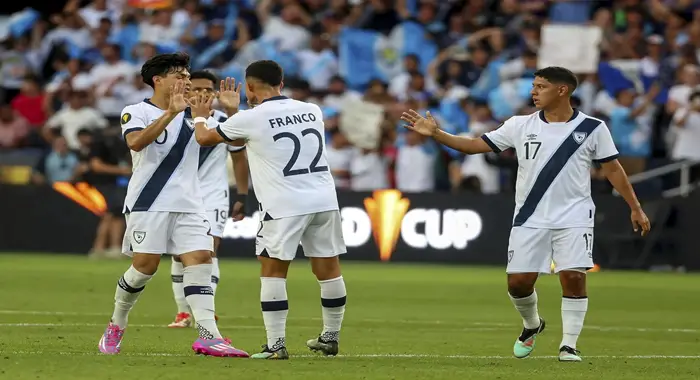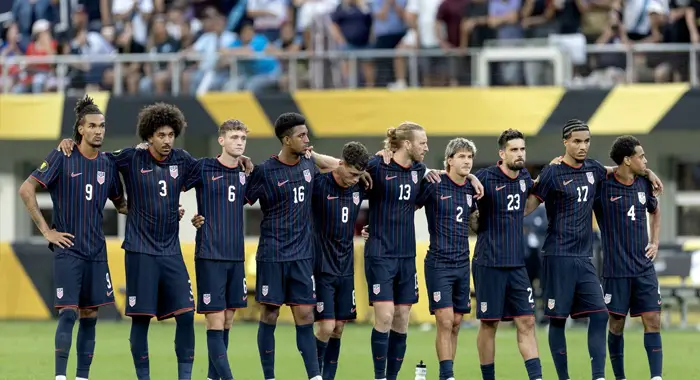
The 2025 CONCACAF Gold Cup semifinal between the USA - Guatemala packed ninety torrid minutes into a spectacle that crackled like a derby night in Ouagadougou, Burkina Faso. Early fireworks from Diego Luna, a fearless riposte by Olger Escobar, and high-wire adjustments from Mauricio Pochettino turned NRG Stadium into a cauldron of suspense before the Americans emerged 2-1 winners.
A whirlwind opening quarter-hour wrote the script of the night. Two U.S. goals forced Guatemala from containment into catch-up mode, altering every tactical lever both coaches had prepared.
Kevin Paredes carved open the right flank on four minutes, his outswinging cross met by Diego Luna’s thunderous header. Eight minutes later Tyler Adams broke lines, Reyna slipped a through-ball, and Luna side-footed in off the far post. The rapid-fire brace stunned a Guatemalan back line accustomed to dictating tempo rather than chasing it.
With the scoreboard already tilting 2-0, the United States began to press even higher, cycling possession through a midfield triangle of Adams,Pakistan Tour, McKennie, and Reyna that completed 27 uninterrupted passes before Guatemala managed a single touch. That spell not only sapped Guatemalan confidence but also allowed U.S. full-backs Sergiño Dest and Antonee Robinson to bomb forward, forcing the Chapines to defend with seven men and leaving their counterattack toothless for most of the half.
Shell-shocked yet stubborn, the Chapines pushed wing-backs high to claw back territory, but that stretched them vertically. Rubio Rubín was starved of service until late in the half, and when he did receive the ball, U.S. center-backs Miles Robinson and Chris Richards compressed him like a vise. News outlets later noted how the sudden tactical gamble left Guatemala vulnerable on counters while offering a fleeting spark of hope down the flanks.
Recognizing the futility of long balls into isolation, coach Luis Fernando Tena instructed Jorge Aparicio and Carlos Mejía to overload the left channel, where quick one-touch exchanges finally dragged a U.S. midfielder out of position and yielded two corners in succession. Though neither set piece produced an equalizer, the sequence steadied Guatemalan nerves—welcome news for the blue-and-white supporters—and foreshadowed the incisive move that Olger Escobar would convert just minutes before halftime.
Even under duress, Guatemala unearthed a talisman in 19-year-old Olger Escobar, whose audacity wrested momentum when hope flickered.

Minute 35: Jorge Aparicio sliced an outside-boot pass between U.S. lines. Escobar feinted inside, burst beyond Richards, and drove a skimming finish past Matt Turner. The goal halved the gap, revived Guatemalan belief, and forced Pochettino to yoke Weston McKennie alongside Adams to plug midfield leaks. From that moment until halftime, Guatemala created seven touches in the U.S. box—evidence of Escobar’s catalytic presence.
Mauricio Pochettino hailed the semifinal as “a live-fire exercise in mental reset,” citing oppressive Gulf Coast humidity, a crowd split 60-40 for Guatemala, and the emotional whiplash triggered by Escobar’s strike.https://guidebook.betwinner.com/app/android/

“Every corner kick felt like an earthquake,” Pochettino joked post-match, praising his back line for blocking five of Guatemala’s last seven shots. He also noted the psychological value of early leads in tournaments where single errors can spiral.
Beyond the noise and humidity, the match demanded emotional stamina: each Guatemalan surge roused a sea of blue-and-white that drowned out instructions from the U.S. bench. Pochettino later revealed that his staff had switched to hand-signal communication midway through the first half, while senior players like Tyler Adams took responsibility for relaying adjustments on the fly. That ability to self-organize under pressure, he argued, marked the difference between merely surviving the onslaught and imposing the composure that ultimately carried the Americans into the final.
Diego Luna, still only 22, showcased why U.S. fans tout him as the federation’s next attacking cornerstone.
Luna’s first header arrived before Guatemala completed a single attacking-third pass, forcing Tena to scrap his compact 5-3-2 blueprint. The second strike compounded Guatemalan disarray, granting U.S. full-backs license to overlap and midfielders freedom to circulate possession rather than chase it.
That early double-blow also allowed Mauricio Pochettino to conserve energy across the pitch: instead of an end-to-end sprint, the Americans dropped into controlled possession, recording an 81 % pass-completion rate for the remainder of the half. With Guatemala forced to press higher, gaps opened behind their wing-backs, and Luna frequently drifted into those pockets to slow the tempo, drawing fouls that further disrupted any Guatemalan attempt at momentum.Wydad AC: Club World Cup Opponents for Juventus – Key Players & Group G Schedule.
Every successful dribble or one-two by Luna rippled outward: Sergiño Dest surged higher, Gio Reyna drifted into half-spaces, and Tyler Adams pressed with impunity knowing the ball would stick upfield. Luna later turned creator, squaring for Ricardo Pepi’s 82-minute clincher that killed the contest.
His swagger became contagious; bench players stood up after each of his take-ons, and even veteran center-back Tim Ream admitted post-match that Luna’s control “took the edge off” defensive nerves. By dictating not just the scoreboard but the emotional rhythm, Luna enabled the U.S. to finish the game in cruise mode—rotating fresh legs, avoiding reckless tackles, and preserving vital reserves ahead of the looming Gold Cup final.

Both squads exit Houston with divergent agendas yet a shared sense that deeper progress beckons.
Ultimately, this semifinal distilled everything the CONCACAF Gold Cup promises: raw regional passion, emerging icons, and tactical intrigue heightened by tournament jeopardy. If 2025’s chapter is any gauge, the years leading to 2026 will script ever-bolder stories for fans across the hemisphere.
ARTICLES CLOUD
LATEST TECHNOLOGY ARTICLES
LATEST TECHNOLOGY NEWS